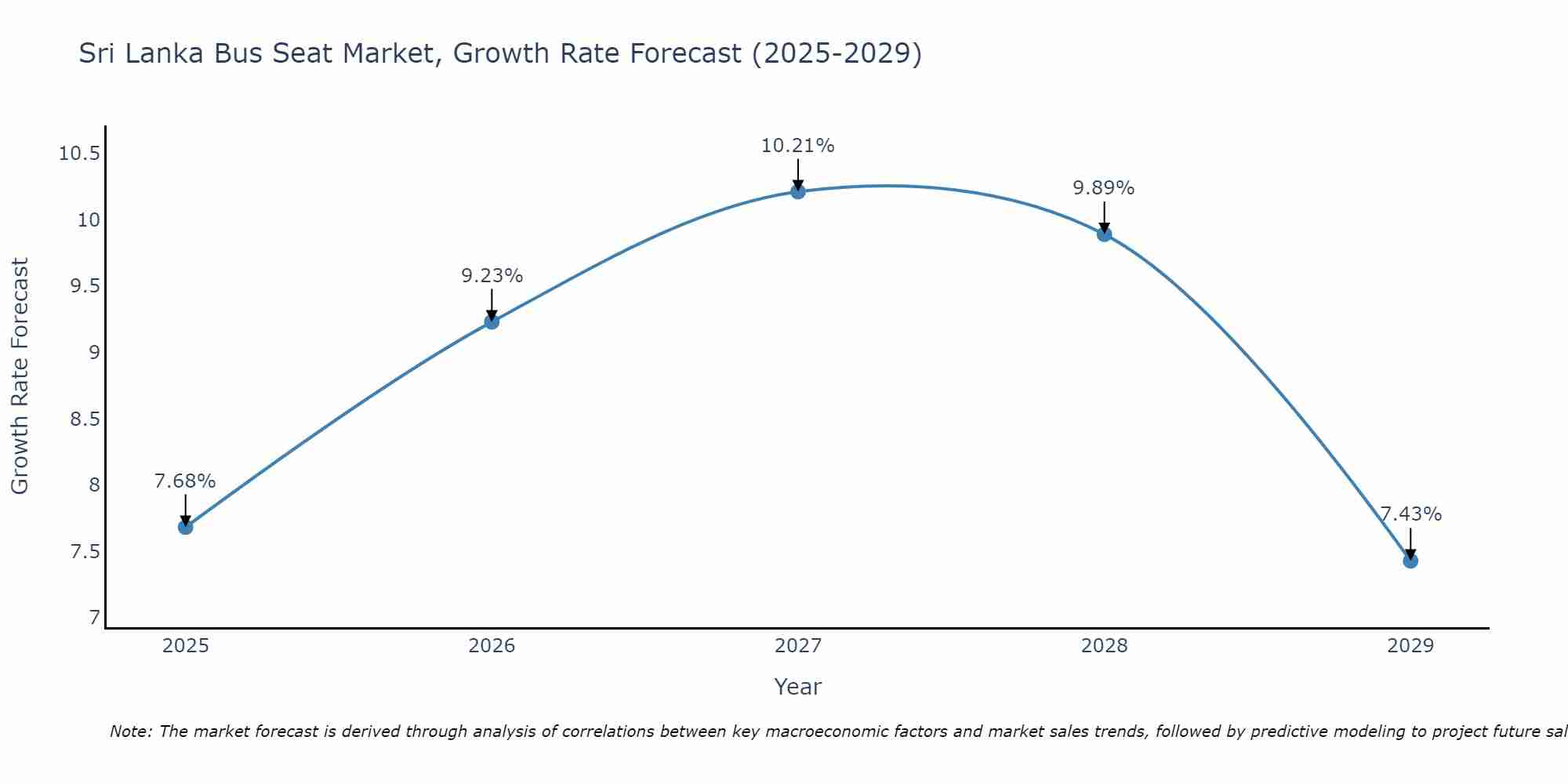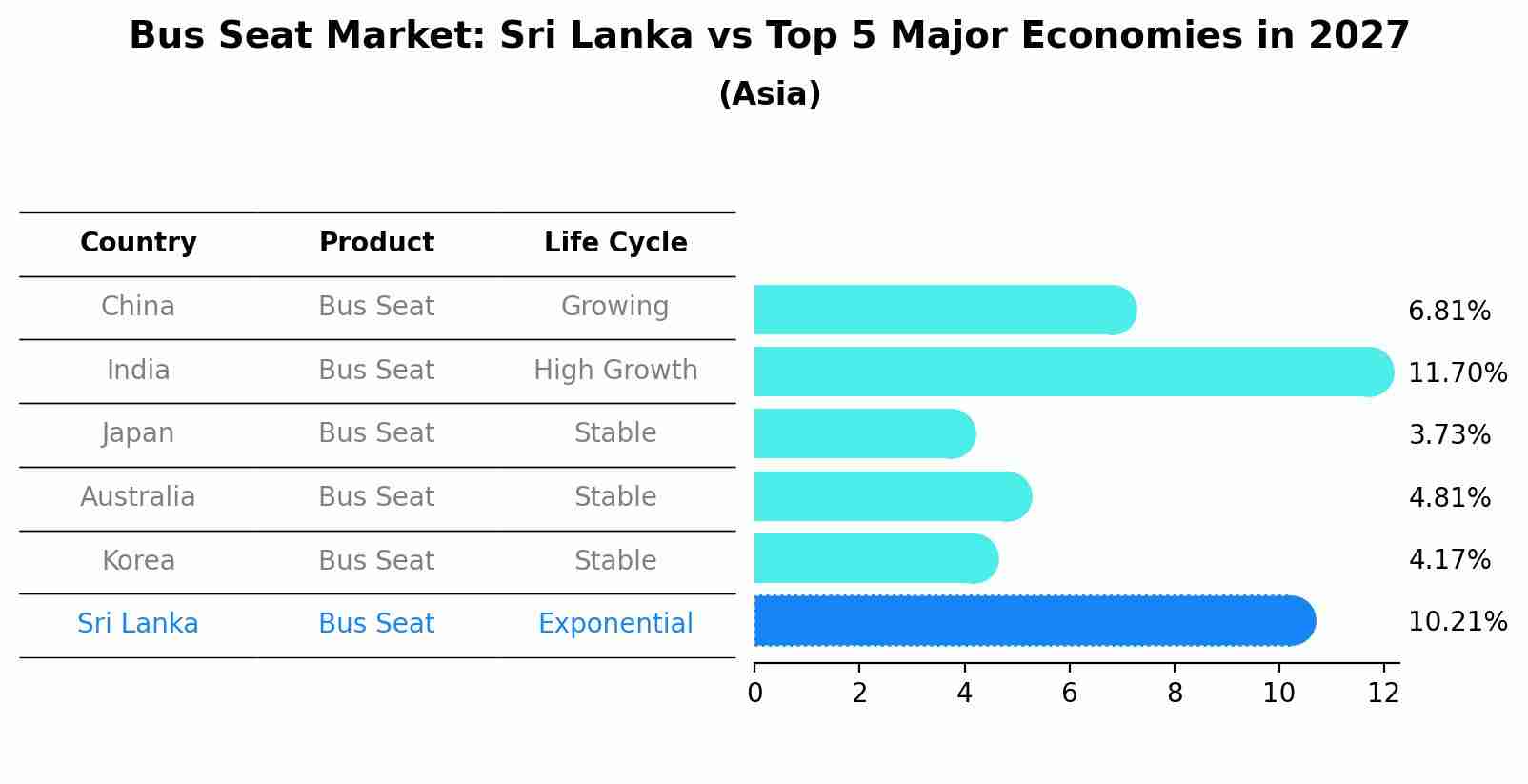Sri Lanka Bus Seat Market Outlook | Companies, Trends, Share, Growth, Value, Analysis, Industry, COVID-19 IMPACT, Revenue, Size & Forecast
| Product Code: ETC371071 | Publication Date: Aug 2022 | Updated Date: Jul 2025 | Product Type: Market Research Report | |
| Publisher: 6Wresearch | Author: Sumit Sagar | No. of Pages: 75 | No. of Figures: 35 | No. of Tables: 20 |
Sri Lanka Bus Seat Market Size Growth Rate
The Sri Lanka Bus Seat Market is projected to witness mixed growth rate patterns during 2025 to 2029. Starting at 7.68% in 2025, the market peaks at 10.21% in 2027, and settles at 7.43% by 2029.

Bus Seat Market: Sri Lanka vs Top 5 Major Economies in 2027 (Asia)
Sri Lanka's Bus Seat market is anticipated to experience a high growth rate of 10.21% by 2027, reflecting trends observed in the largest economy China, followed by India, Japan, Australia and South Korea.

Sri Lanka Bus Seat Market Synopsis
The Sri Lanka Bus Seat Market is witnessing steady growth driven by the country`s expanding public transportation network and the increasing demand for comfortable seating options. With a significant number of buses operating across the island, there is a continuous need for high-quality and durable bus seats that provide comfort and safety to passengers. Manufacturers in the market are focusing on developing innovative designs that offer ergonomic support and enhanced features such as reclining options, armrests, and adjustable headrests. Additionally, there is a growing trend towards the use of eco-friendly and easy-to-maintain materials in bus seat production. The market is competitive with both local and international players catering to the diverse needs of Sri Lanka`s bus operators and transportation companies.
Sri Lanka Bus Seat Market Trends
The Sri Lanka Bus Seat Market is currently experiencing a trend towards more ergonomic and comfortable seating options. With an increasing focus on passenger comfort and safety, bus operators are opting for seats that offer better lumbar support, adjustable headrests, and improved cushioning. Another notable trend is the shift towards eco-friendly and sustainable materials in bus seat manufacturing, in line with global sustainability initiatives. Furthermore, there is a growing demand for seats with integrated features such as USB charging ports, entertainment systems, and enhanced reclining capabilities to enhance the overall passenger experience. As the bus transportation sector in Sri Lanka continues to evolve, bus seat manufacturers are expected to innovate further to meet the changing demands of both operators and passengers.
Sri Lanka Bus Seat Market Challenges
In the Sri Lanka bus seat market, several challenges are faced by manufacturers and suppliers. One major challenge is the increasing competition from both domestic and international players, leading to price pressures and margin erosion. Another challenge is the fluctuating raw material prices, especially for materials like foam, fabric, and metal components, impacting the overall production costs. Additionally, the fragmented nature of the market with a large number of small and medium-sized players makes it difficult for companies to establish a strong market presence and brand identity. Furthermore, the lack of standardization in bus seat designs and specifications often leads to customization requirements, increasing production complexity and costs. Overall, addressing these challenges requires companies to focus on innovation, cost-efficiency, and strategic partnerships to remain competitive in the Sri Lanka bus seat market.
Sri Lanka Bus Seat Market Investment Opportunities
The Sri Lanka Bus Seat Market offers promising investment opportunities due to the country`s growing public transportation sector and increasing demand for comfortable and safe seating solutions. With the government`s focus on improving public transportation infrastructure, there is a need for high-quality and durable bus seats that can enhance passenger experience. Investing in innovative and ergonomic bus seat designs that prioritize passenger comfort, safety, and durability could be a lucrative opportunity in this market. Additionally, with the rising trend of eco-friendly transportation, there is a growing demand for sustainable and environmentally friendly bus seat materials. Collaborating with bus manufacturers and operators to provide customized seating solutions tailored to their specific needs could also be a strategic investment approach in the Sri Lanka Bus Seat Market.
Jordan Agar Market Government Policies
In Sri Lanka, the government has implemented various policies related to the bus seat market to ensure passenger safety and fair competition among operators. The National Transport Commission (NTC) regulates bus services and sets standards for seat design, capacity, and safety features to protect passengers. Additionally, the government enforces pricing regulations to prevent unfair practices and ensure affordable fares for commuters. Bus operators are required to adhere to specific guidelines on seating arrangements, cleanliness, and maintenance to maintain operating licenses. The government also promotes the use of eco-friendly buses and encourages operators to invest in modernizing their fleets to improve overall service quality. Overall, these policies aim to create a safe, efficient, and sustainable bus seat market in Sri Lanka.
Sri Lanka Bus Seat Market Future Outlook
The future outlook for the Sri Lanka bus seat market is expected to be positive, driven by factors such as urbanization, increasing disposable incomes, and government initiatives to improve public transportation infrastructure. With a growing population and rising demand for public transportation, there will be a need for more comfortable and durable bus seats to cater to the increasing number of passengers. Additionally, the trend towards modernizing bus fleets and adopting advanced seating technologies is likely to further boost the market growth. As a result, bus seat manufacturers and suppliers in Sri Lanka are expected to experience opportunities for expansion and innovation in the coming years to meet the evolving needs of the market.
Key Highlights of the Report:
- Sri Lanka Bus Seat Market Outlook
- Market Size of Sri Lanka Bus Seat Market, 2021
- Forecast of Sri Lanka Bus Seat Market, 2031
- Historical Data and Forecast of Sri Lanka Bus Seat Revenues & Volume for the Period 2018 - 2031
- Sri Lanka Bus Seat Market Trend Evolution
- Sri Lanka Bus Seat Market Drivers and Challenges
- Sri Lanka Bus Seat Price Trends
- Sri Lanka Bus Seat Porter's Five Forces
- Sri Lanka Bus Seat Industry Life Cycle
- Historical Data and Forecast of Sri Lanka Bus Seat Market Revenues & Volume By Seat Type for the Period 2018 - 2031
- Historical Data and Forecast of Sri Lanka Bus Seat Market Revenues & Volume By Standard for the Period 2018 - 2031
- Historical Data and Forecast of Sri Lanka Bus Seat Market Revenues & Volume By Recliner for the Period 2018 - 2031
- Historical Data and Forecast of Sri Lanka Bus Seat Market Revenues & Volume By Component Type for the Period 2018 - 2031
- Historical Data and Forecast of Sri Lanka Bus Seat Market Revenues & Volume By Frame for the Period 2018 - 2031
- Historical Data and Forecast of Sri Lanka Bus Seat Market Revenues & Volume By Upholstery for the Period 2018 - 2031
- Sri Lanka Bus Seat Import Export Trade Statistics
- Market Opportunity Assessment By Seat Type
- Market Opportunity Assessment By Component Type
- Sri Lanka Bus Seat Top Companies Market Share
- Sri Lanka Bus Seat Competitive Benchmarking By Technical and Operational Parameters
- Sri Lanka Bus Seat Company Profiles
- Sri Lanka Bus Seat Key Strategic Recommendations
Frequently Asked Questions About the Market Study (FAQs):
- Single User License$ 1,995
- Department License$ 2,400
- Site License$ 3,120
- Global License$ 3,795
Search
Thought Leadership and Analyst Meet
Our Clients
Related Reports
- Afghanistan Apparel Market (2026-2032) | Growth, Outlook, Industry, Segmentation, Forecast, Size, Companies, Trends, Value, Share, Analysis & Revenue
- Canada Oil and Gas Market (2026-2032) | Share, Segmentation, Value, Industry, Trends, Forecast, Analysis, Size & Revenue, Growth, Competitive Landscape, Outlook, Companies
- Germany Breakfast Food Market (2026-2032) | Industry, Share, Growth, Size, Companies, Value, Analysis, Revenue, Trends, Forecast & Outlook
- Australia Briquette Market (2025-2031) | Growth, Size, Revenue, Forecast, Analysis, Trends, Value, Share, Industry & Companies
- Vietnam System Integrator Market (2025-2031) | Size, Companies, Analysis, Industry, Value, Forecast, Growth, Trends, Revenue & Share
- ASEAN and Thailand Brain Health Supplements Market (2025-2031) | Strategy, Consumer Insights, Analysis, Investment Trends, Opportunities, Growth, Size, Share, Industry, Revenue, Segments, Value, Segmentation, Supply, Forecast, Restraints, Outlook, Competition, Drivers, Trends, Demand, Pricing Analysis, Competitive, Strategic Insights, Companies, Challenges
- ASEAN Bearings Market (2025-2031) | Strategy, Consumer Insights, Analysis, Investment Trends, Opportunities, Growth, Size, Share, Industry, Revenue, Segments, Value, Segmentation, Supply, Forecast, Restraints, Outlook, Competition, Drivers, Trends, Demand, Pricing Analysis, Competitive, Strategic Insights, Companies, Challenges
- Europe Flooring Market (2025-2031) | Outlook, Share, Industry, Trends, Forecast, Companies, Revenue, Size, Analysis, Growth & Value
- Saudi Arabia Manlift Market (2025-2031) | Outlook, Size, Growth, Trends, Companies, Industry, Revenue, Value, Share, Forecast & Analysis
- Uganda Excavator, Crane, and Wheel Loaders Market (2025-2031) | Strategy, Consumer Insights, Analysis, Investment Trends, Opportunities, Growth, Size, Share, Industry, Revenue, Segments, Value, Segmentation, Supply, Forecast, Restraints, Outlook, Competition, Drivers, Trends, Demand, Pricing Analysis, Competitive, Strategic Insights, Companies, Challenges
Industry Events and Analyst Meet
Whitepaper
- Middle East & Africa Commercial Security Market Click here to view more.
- Middle East & Africa Fire Safety Systems & Equipment Market Click here to view more.
- GCC Drone Market Click here to view more.
- Middle East Lighting Fixture Market Click here to view more.
- GCC Physical & Perimeter Security Market Click here to view more.
6WResearch In News
- Doha a strategic location for EV manufacturing hub: IPA Qatar
- Demand for luxury TVs surging in the GCC, says Samsung
- Empowering Growth: The Thriving Journey of Bangladesh’s Cable Industry
- Demand for luxury TVs surging in the GCC, says Samsung
- Video call with a traditional healer? Once unthinkable, it’s now common in South Africa
- Intelligent Buildings To Smooth GCC’s Path To Net Zero


















